Bài giảng Cơ sở kĩ thuật dầu khí - Chương 7: Well completion and stimulation
Chương 7: Well completion and stimulation
CONTENTS
1. Basic Completion Methods
2. Completion Procedure
3. Perforating
4. Stimulation
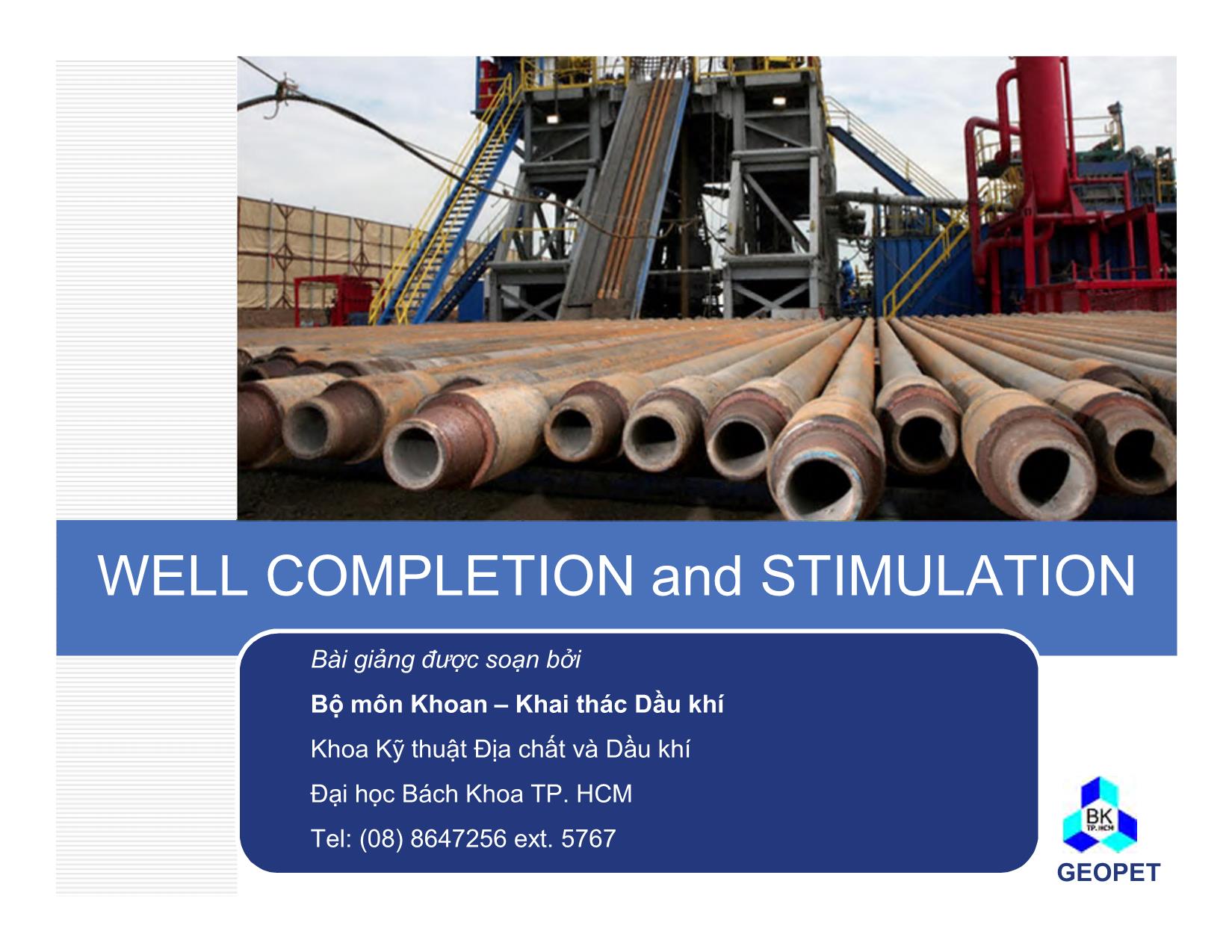
Trang 1
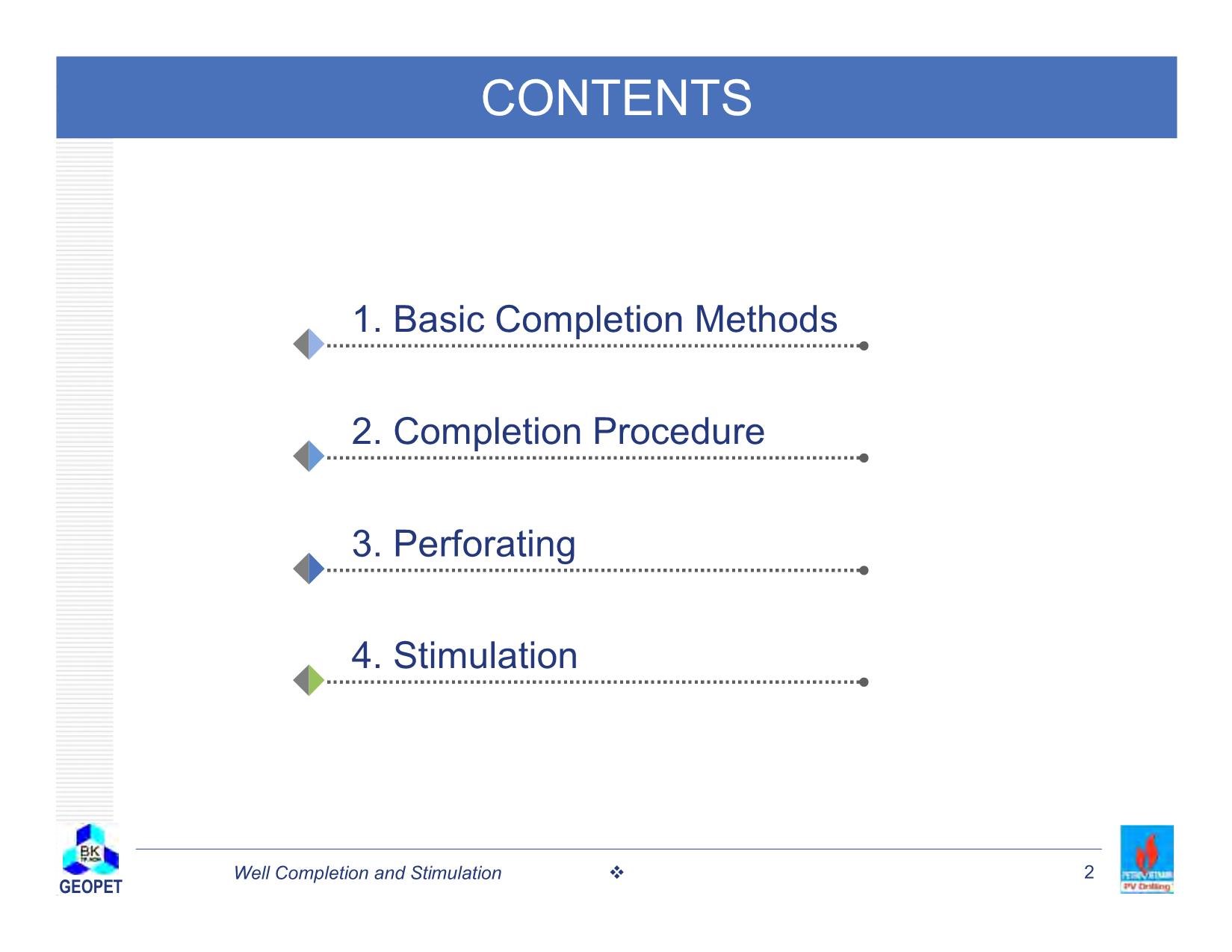
Trang 2
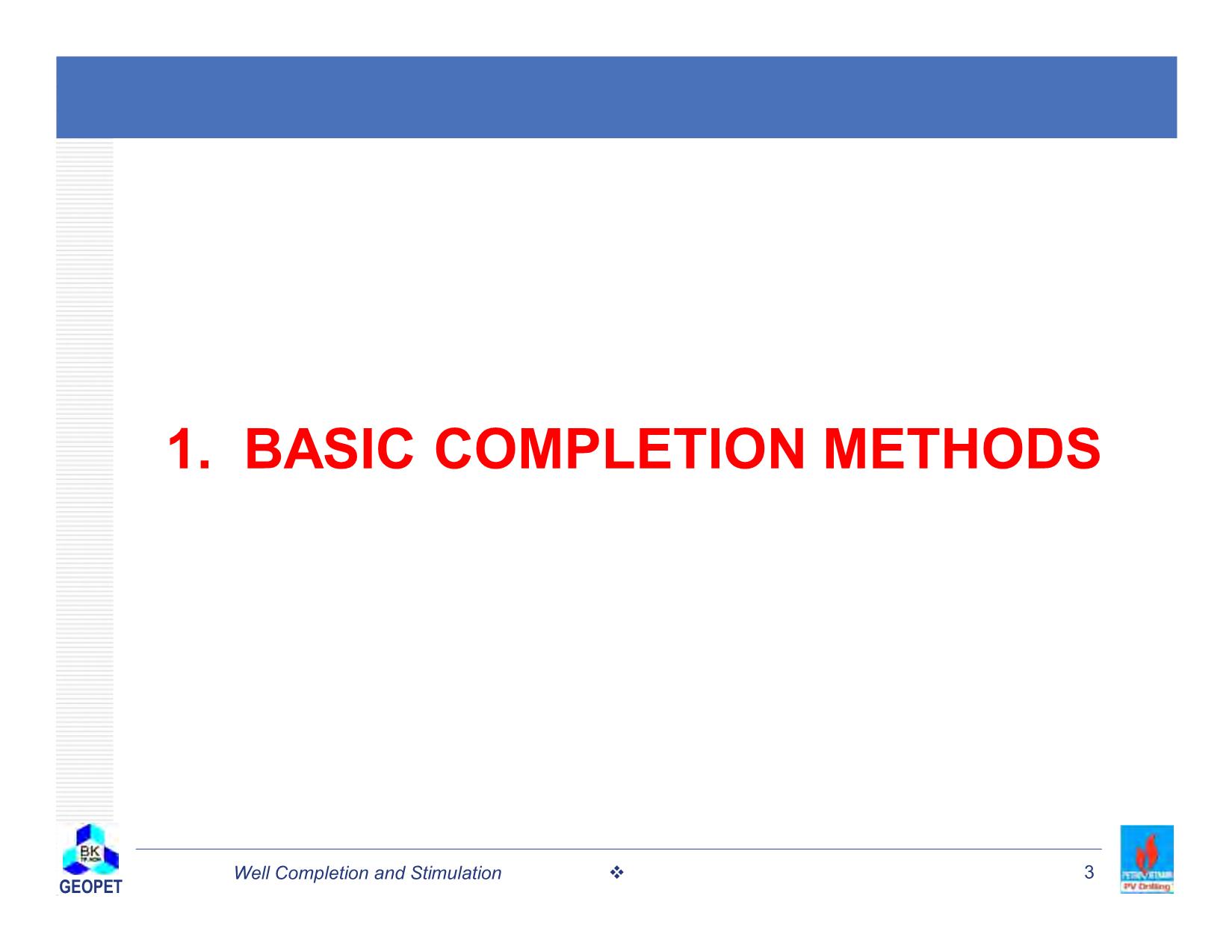
Trang 3
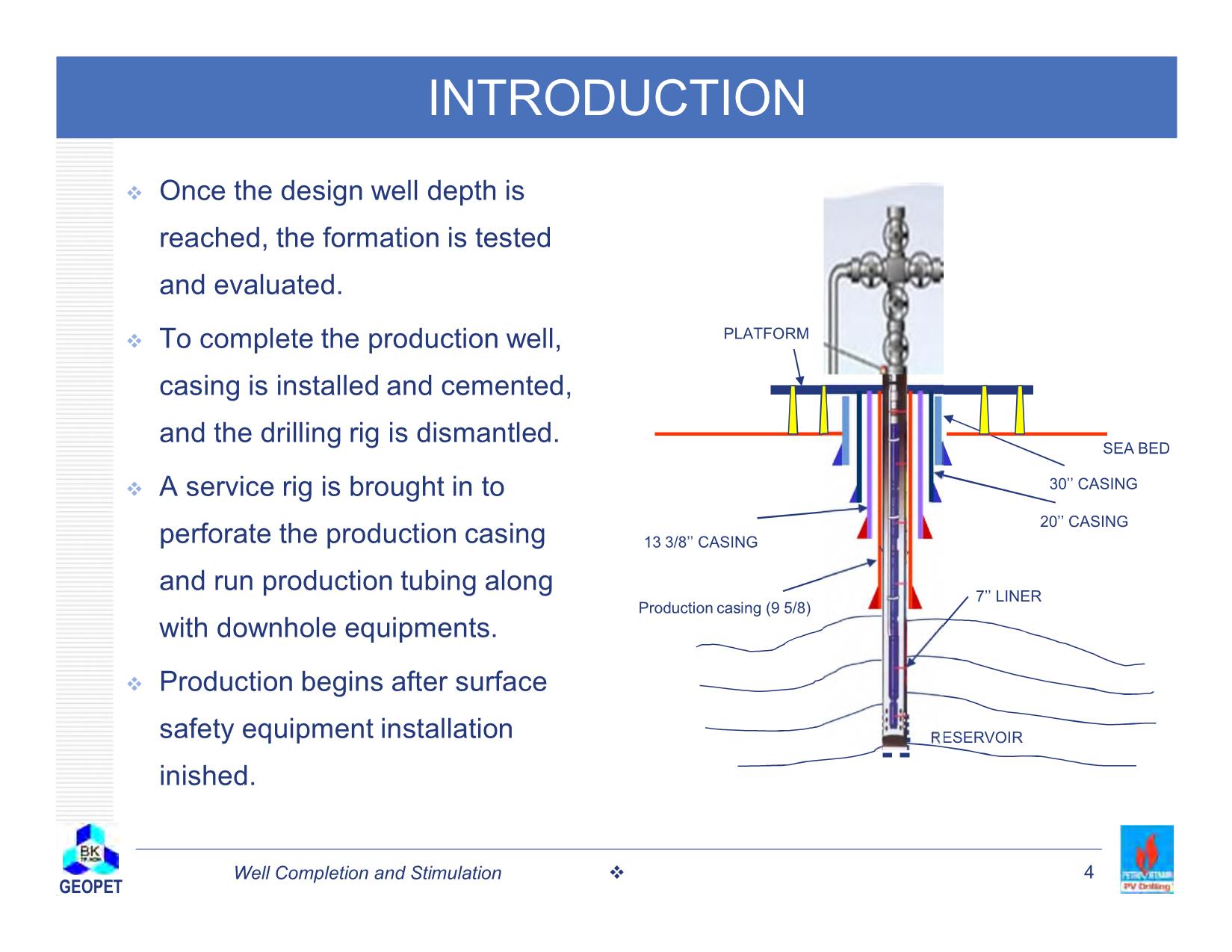
Trang 4
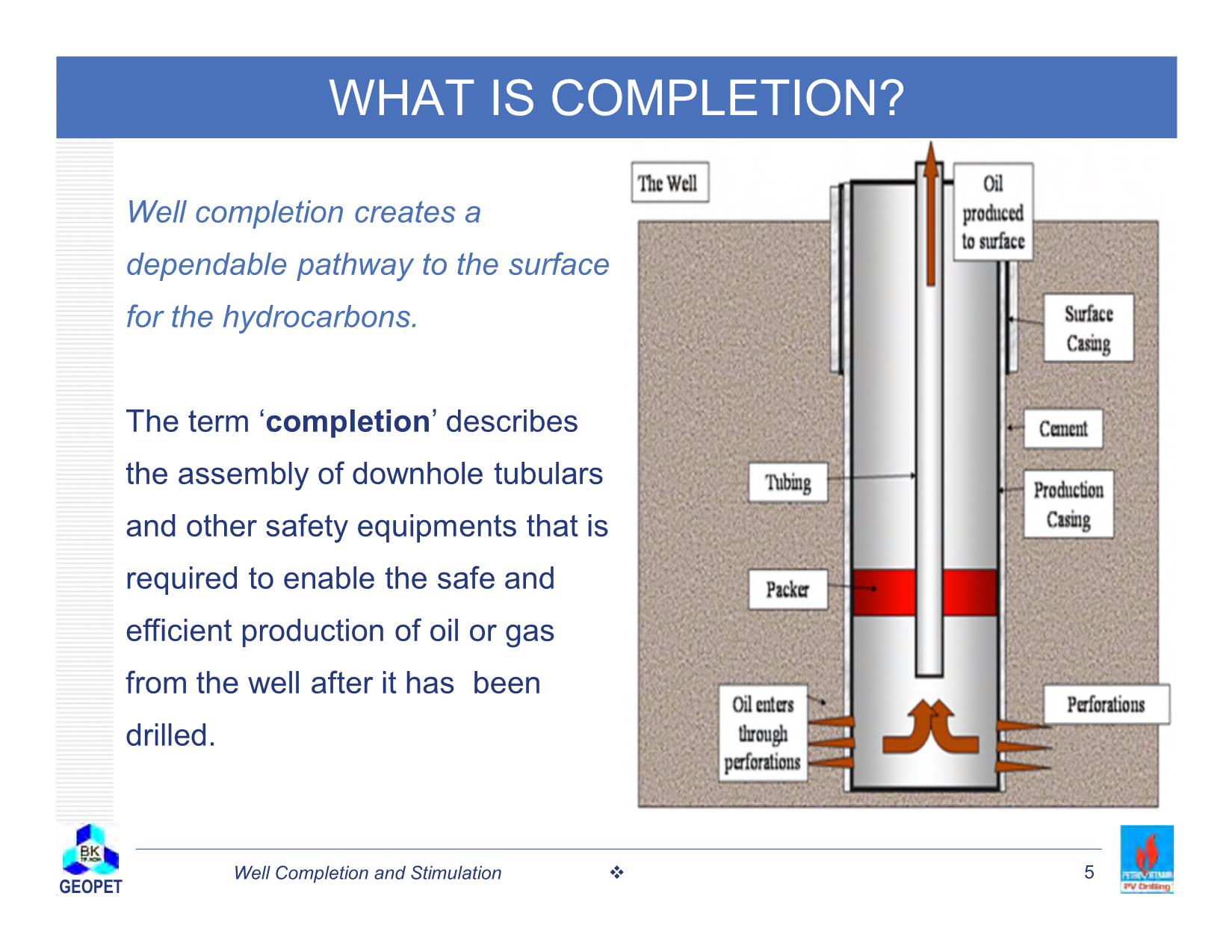
Trang 5
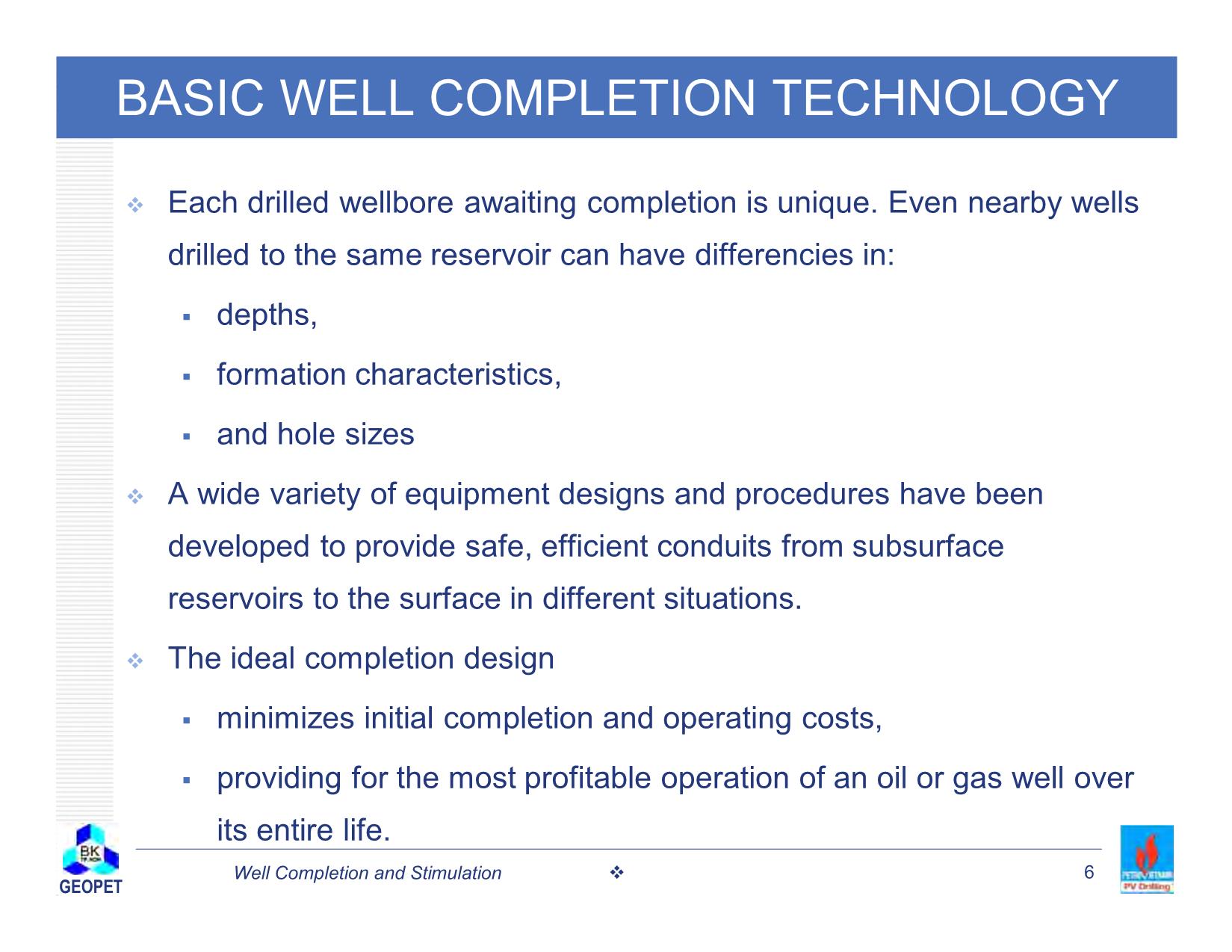
Trang 6
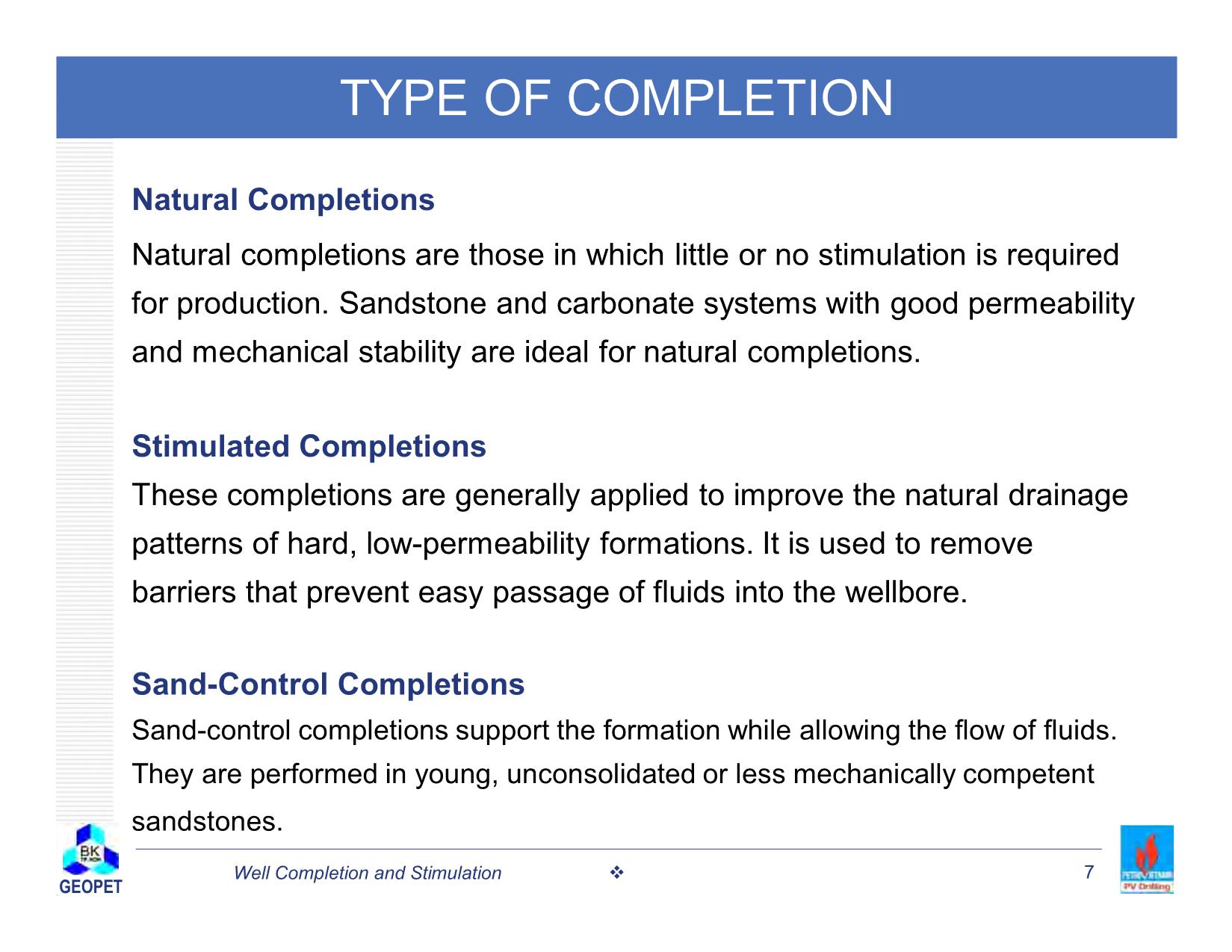
Trang 7
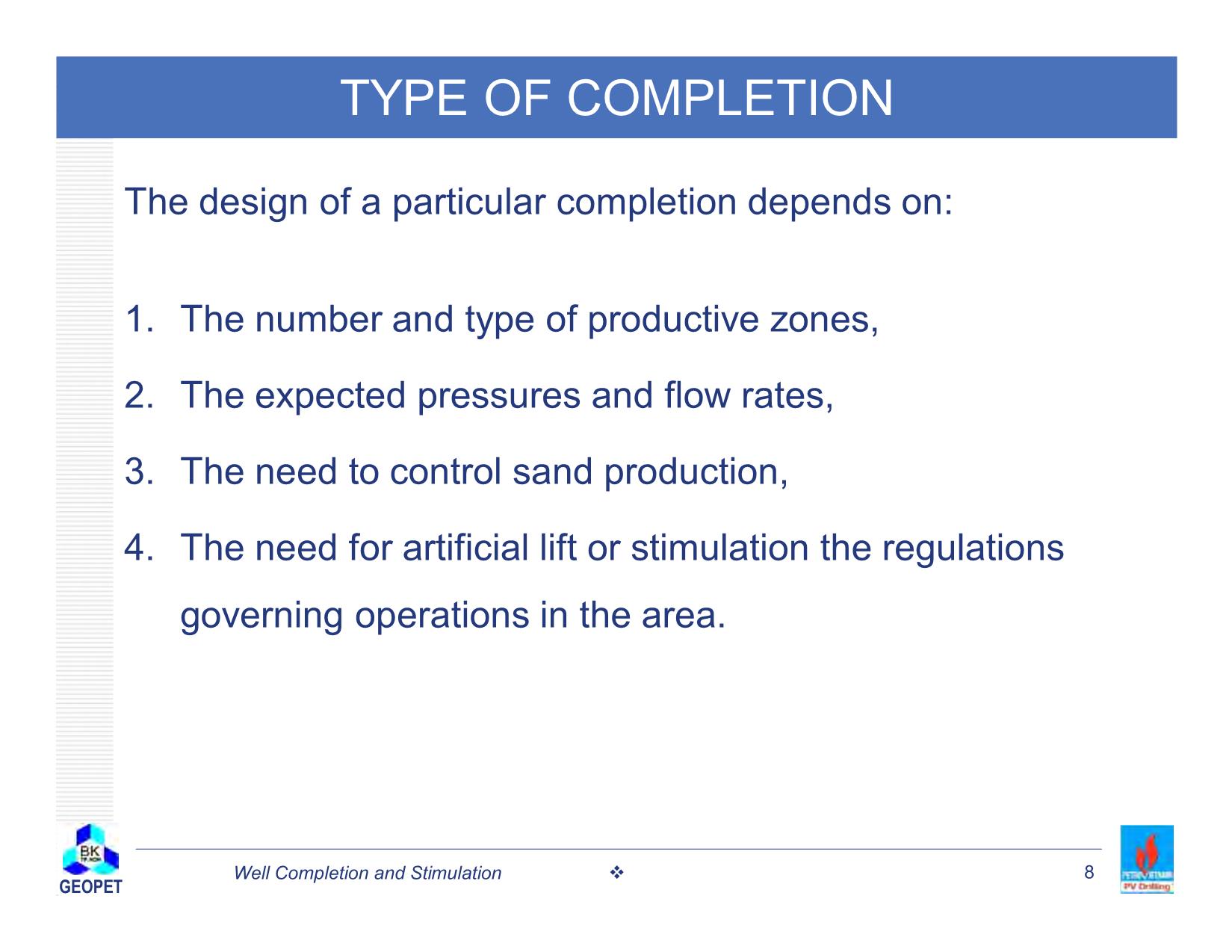
Trang 8
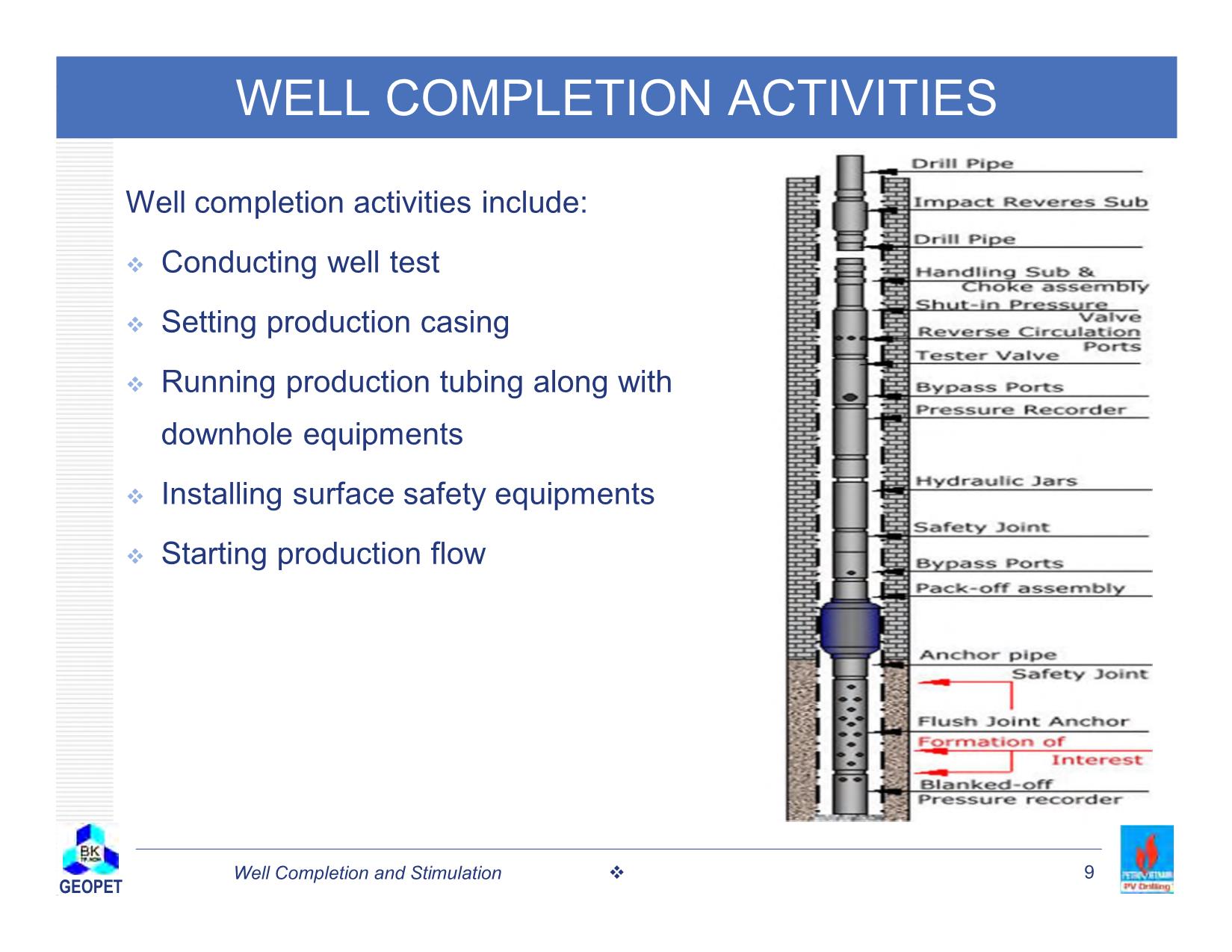
Trang 9
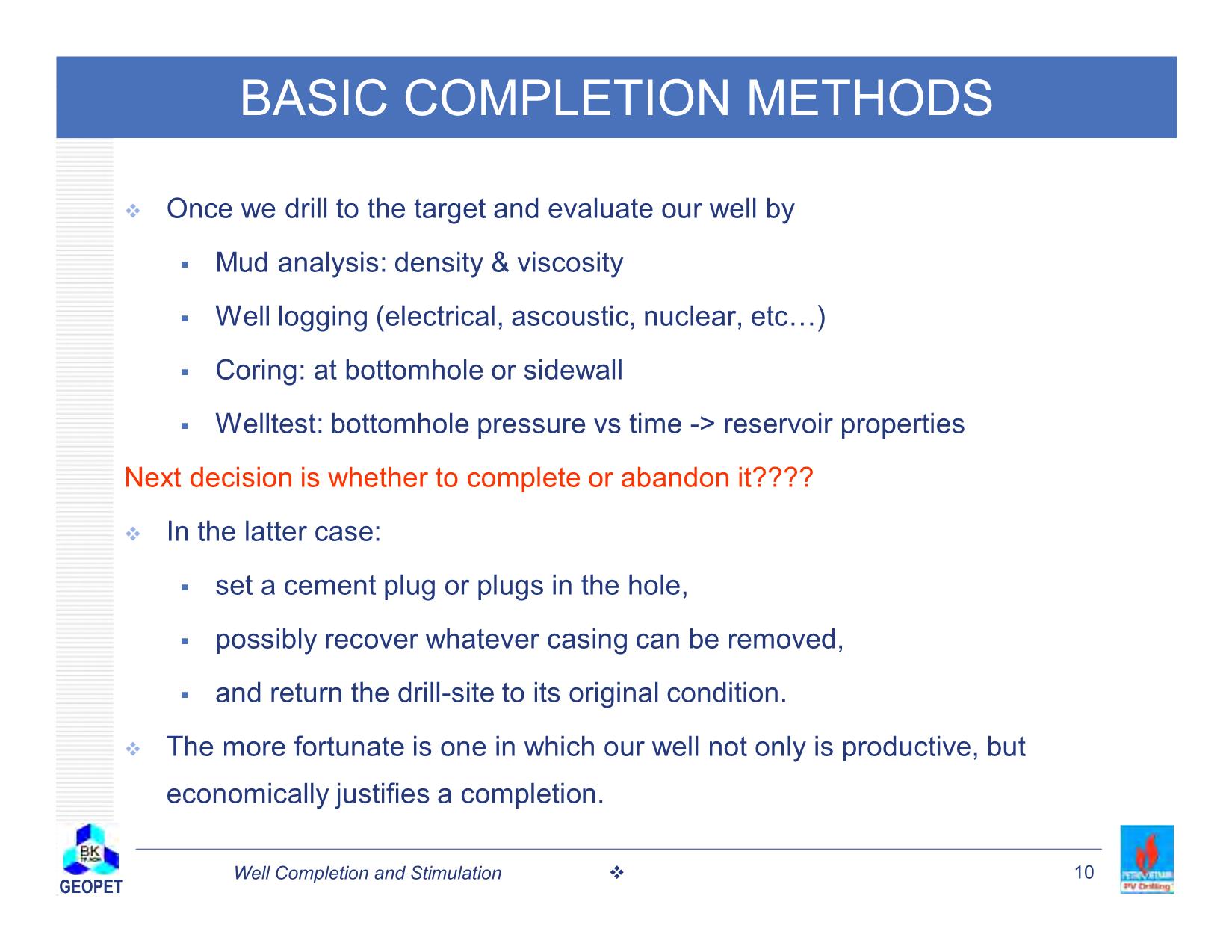
Trang 10
Tải về để xem bản đầy đủ
Bạn đang xem 10 trang mẫu của tài liệu "Bài giảng Cơ sở kĩ thuật dầu khí - Chương 7: Well completion and stimulation", để tải tài liệu gốc về máy hãy click vào nút Download ở trên
Tóm tắt nội dung tài liệu: Bài giảng Cơ sở kĩ thuật dầu khí - Chương 7: Well completion and stimulation
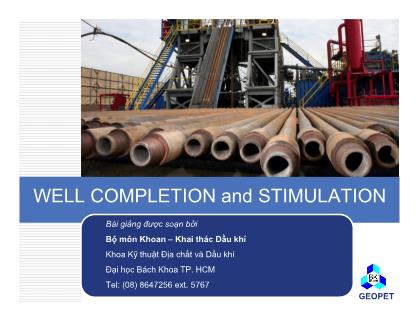
WELL COMPLETION and STIMULATION
GEOPET
Bài giảng được soạn bởi
Bộ môn Khoan – Khai thác Dầu khí
Khoa Kỹ thuật Địa chất và Dầu khí
Đại học Bách Khoa TP. HCM
Tel: (08) 8647256 ext. 5767
GEOPET
Well Completion and Stimulation 2
CONTENTS
1. Basic Completion Methods
2. Completion Procedure
3. Perforating
4. Stimulation
GEOPET
Well Completion and Stimulation 3
1. BASIC COMPLETION METHODS
GEOPET
Well Completion and Stimulation 4
Once the design well depth is
reached, the formation is tested
and evaluated.
To complete the production well,
casing is installed and cemented,
and the drilling rig is dismantled.
A service rig is brought in to
perforate the production casing
and run production tubing along
with downhole equipments.
Production begins after surface
safety equipment installation
inished.
INTRODUCTION
30’’ CASING
20’’ CASING
13 3/8’’ CASING
7’’ LINER
RESERVOIR
SEA BED
PLATFORM
Production casing (9 5/8)
GEOPET
Well Completion and Stimulation 5
WHAT IS COMPLETION?
Well completion creates a
dependable pathway to the surface
for the hydrocarbons.
The term ‘completion’ describes
the assembly of downhole tubulars
and other safety equipments that is
required to enable the safe and
efficient production of oil or gas
from the well after it has been
drilled.
GEOPET
Well Completion and Stimulation 6
BASIC WELL COMPLETION TECHNOLOGY
Each drilled wellbore awaiting completion is unique. Even nearby wells
drilled to the same reservoir can have differencies in:
depths,
formation characteristics,
and hole sizes
A wide variety of equipment designs and procedures have been
developed to provide safe, efficient conduits from subsurface
reservoirs to the surface in different situations.
The ideal completion design
minimizes initial completion and operating costs,
providing for the most profitable operation of an oil or gas well over
its entire life.
GEOPET
Well Completion and Stimulation 7
Natural Completions
Natural completions are those in which little or no stimulation is required
for production. Sandstone and carbonate systems with good permeability
and mechanical stability are ideal for natural completions.
Stimulated Completions
These completions are generally applied to improve the natural drainage
patterns of hard, low-permeability formations. It is used to remove
barriers that prevent easy passage of fluids into the wellbore.
Sand-Control Completions
Sand-control completions support the formation while allowing the flow of fluids.
They are performed in young, unconsolidated or less mechanically competent
sandstones.
TYPE OF COMPLETION
GEOPET
Well Completion and Stimulation 8
TYPE OF COMPLETION
The design of a particular completion depends on:
1. The number and type of productive zones,
2. The expected pressures and flow rates,
3. The need to control sand production,
4. The need for artificial lift or stimulation the regulations
governing operations in the area.
GEOPET
Well Completion and Stimulation 9
WELL COMPLETION ACTIVITIES
Well completion activities include:
Conducting well test
Setting production casing
Running production tubing along with
downhole equipments
Installing surface safety equipments
Starting production flow
GEOPET
Well Completion and Stimulation 10
BASIC COMPLETION METHODS
Once we drill to the target and evaluate our well by
Mud analysis: density & viscosity
Well logging (electrical, ascoustic, nuclear, etc)
Coring: at bottomhole or sidewall
Welltest: bottomhole pressure vs time -> reservoir properties
Next decision is whether to complete or abandon it????
In the latter case:
set a cement plug or plugs in the hole,
possibly recover whatever casing can be removed,
and return the drill-site to its original condition.
The more fortunate is one in which our well not only is productive, but
economically justifies a completion.
GEOPET
Well Completion and Stimulation 11
The next step usually involves the running of the final string of casing - the
production string.
The manner in which this is done determines the basic completion
method and may follow one of several configurations: (interface between
the wellbore & reservoir)
the openhole completion,
the liner completion,
the cased and perforated completion
• Without liner
• With liner
BASIC COMPLETION METHODS
GEOPET
Well Completion and Stimulation 12
The openhole completion: the producing formation is not isolated by
the casing, which extends only to the top of the producing interval.
The slotted liner completion: which is not cemented and not "tied back"
to the surface.
BASIC COMPLETION METHODS
GEOPET
Well Completion and Stimulation 13
The cased and perforated completion
Without liner: cementing the production casing across the
productive interval and then perforating the casing for production
With liner: a liner is cemented and perforated as a cased and
perforated completion
BASIC COMPLETION METHODS
GEOPET
Well Completion and Stimulation 14
One of these configurations will be the basis for the completion design,
which may incorporate:
one or multiple strings of tubing: single, dual, or triple, etc
and a variety of tubing components to facilitate production
(production method): pumping, flowing, etc.
from one or multiple zones: single or multiple zones
For our purposes, a cased and perforated well with a single tubing
string will serve to illustrate the typical completion procedure.
BASIC COMPLETION METHODS
GEOPET
Well Completion and Stimulation 15
Subsea production systems are wells
located on the sea floor, as opposed to
at the surface. The safety equipments
are installed underwater on the seabed.
They enable early production from
deepwater, remote, and marginal fields.
Subsea production system offer a
... y researchers realized that the fracture would close once the
hydraulic pressure was relieved,
a solid material is added to the fracturing fluid to "prop" open the
fracture.
Initial jobs consisted of perhaps 500 to 1000 gallons of gelled kerosene
(napalm) as a fracturing fluid, with perhaps 1/2 lb of sand per gallon
(Neely 1977).
These early fractures were assumed to be horizontal, following
the bedding planes of the rock.
GEOPET
Well Completion and Stimulation 60
FRACTURING
Since that time, an enormous amount of research and field application
of fracturing techniques has been carried out.
Theoretical mathematical models have been developed that permit
engineers to predict the type of fracture and productivity increase that
will result from a certain magnitude fracture treatment.
These calculations prevent the unnecessary use of enormous amounts
of
costly fracture fluid,
proppant material,
and equipment horse power
by tailoring the treatment to the particular well.
GEOPET
Well Completion and Stimulation 61
FRACTURING
Although there is still some disagreement among theorists concerning
the behavior of rock under stress, we now know that:
Fracture orientation is dependent upon geologic conditions,
And that most fractures are vertical rather than horizontal.
GEOPET
Well Completion and Stimulation 62
FRACTURING
In order to significantly improve a well's productivity, a fracture must
conduct fluid at a rate that is several orders of magnitude greater than
the conductivity of the rock itself.
Creating a high-conductivity fracture involves
selecting the appropriate fluid, additives, and proppant,
determining the optimum volume of material to be pumped,
pumping the material at the appropriate rate and pressure.
GEOPET
Well Completion and Stimulation 63
FRACTURING
Desirable features for a fracturing fluid include
the ability to remain in the fracture and not leak off into the formation,
the viscosity necessary to transport the proppant into the fracture,
the ability to flow back into the well easily after depositing the
proppant,
and low cost.
Water-based polymer solutions are popular, as are gel led hydrocarbons
for water-sensitive formations.
A wide variety of additives are available to reduce fluid friction in piping,
prevent fluid loss from the fracture, control contamination, and insure
compatibility with the formation.
GEOPET
Well Completion and Stimulation 64
FRACTURING
The standard proppant used to hold open the fracture is silica sand.
Sand can be crushed, however, in deep formations where fracture-
closure stresses are high.
In such cases sintered bauxite, zirconium oxide, or other high-
strength materials are substituted for sand.
The goal is to create at least a partial monolayer of proppant within the
fracture, holding the fracture open, but not plugging it completely.
GEOPET
Well Completion and Stimulation 65
FRACTURING
High-strength proppant forms a single layer of particle that holds open
the fracture and permits flow
GEOPET
Well Completion and Stimulation 66
FRACTURING
At the wellsite, the equipment required for a large fracturing job is
somewhat more sophisticated than that required for an acid
stimulation.
The fracturing fluid is held in tanks, where any necessary additives are
mixed.
Proppant is sorted in similar containers, from which it is conveyed to
high-rate blenders.
Blenders combine the fracture fluid with the proppant and send the
mixture to the pumping system.
GEOPET
Well Completion and Stimulation 67
FRACTURING
GEOPET
Well Completion and Stimulation 68
FRACTURING
These blenders are critical to the fracturing procedure because, once
the pumping process is under way, interruption of it can result in
bridging of the proppant in the tubing or the fracture.
The job will fail and retreatment will be required.
Often, for major fracturing treatments, large volumes of fluid must be
pumped at high pressure. This usually means that standard size pump
trucks must be hooked up in parallel to a manifold.
The fluid is pumped down the tubing, drillpipe, or casing by this system
into the formation.
A wellhead protector is often inserted through the Christmas tree to
protect its interior from the abrasive, high-pressure fracturing fluid.
GEOPET
Well Completion and Stimulation 69
Sand Control
GEOPET
Well Completion and Stimulation 70
SAND CONTROL
While a certain amount of sediment will always be produced along with
formation fluids, sand control is the technology and practice of
preventing sand flow from unconsolidated sandstone formations.
Such a problem is often found
in Tertiary sediments,
at shallow depths,
and in areas such as Nigeria, Indonesia, Trinidad, Venezuela,
Canada, the U.S. Gulf Coast, and the Los Angeles Basin (Patton
and Abbott 1982).
GEOPET
Well Completion and Stimulation 71
SAND CONTROL
Sand production leads to any or all of the following problems:
Casing collapse;
Abrasion of downhole and surface equipment;
Reduced productivity;
Completely plugged ("sanded-up") wells.
GEOPET
Well Completion and Stimulation 72
SAND CONTROL
Methods for controlling sand production have generally involved one of
three approaches:
an epoxy resin that can be injected into the formation near the
wellbore and allowed to harden; this cements the sand grains
together and by consolidating them prevents their movement.
a metal screen and sand grain barrier that screens out the
formation sand but does not inhibit fluid flow into the wellbore; or
a combined treatment involving fracture stimulation and sand
control, known as a “frac and pack” treatment.
GEOPET
Well Completion and Stimulation 73
SAND CONTROL
Metal wire-wrapped screens and gravel packs work in a manner
analogous to a large crowd of people trying to leave a theatre through
a small door. Each could pass through the door individually, but when
several try at once they form a "bridge" that prevents those at the rear
of the pack from moving at all.
In sand control, bridging methods employ wire-wrapped screens or
slotted casing, both of which have carefully sized openings that allow
the formation sand to be deposited against them.
GEOPET
Well Completion and Stimulation 74
SAND CONTROL
In the case of gravel packs, carefully sized
clean sand is placed outside the screen to
retain the formation sand at its outer edge.
GEOPET
Well Completion and Stimulation 75
SAND CONTROL
Correct sizing of both
the gravel pack sand
and the gravel pack screen
requires knowledge of the information about formation grain size
distribution that had been obtained from cores.
Guidelines have been developed to select sand and screen sizes that
will prevent formation sand movement but not inhibit formation fluid
flow.
Gravel packing may be carried out in an openhole completion in which
under-reaming has enlarged the volume of the pack to enlarge the
hole prior to placing the gravel pack sand outside the screen by the
reverse circulation technique.
GEOPET
Well Completion and Stimulation 76
SAND CONTROL
Typical Open Hole Gravel Pack Installation Typical Cased Hole Gravel Pack Installation
GEOPET
Well Completion and Stimulation 77
SAND CONTROL
An inside gravel pack may also be accomplished in a cased and
perforated completion.
Three common types of inside gravel packing are shown in
1. Wash down, where the gravel is placed in the hole and the screen
“washed” through it by circulating,
2. Reverse circulation, where the sand is pumped down the annulus
and the carrying fluid returned up the tubing,
3. Crossover allows the sand slurry to be pumped down the tubing,
depending on the method of sand placement.
GEOPET
Well Completion and Stimulation 78
SAND CONTROL
Wash down Reverse
circulation
Cross over
GEOPET
Well Completion and Stimulation 79
SAND CONTROL
Gravel packs require
There is a good bond between casing and formation,
The perforations be large and free of debris,
and that the gravel pack sand is
Evenly placed around the screen
And not mixed with formation sand or dirty completion fluid.
GEOPET
Well Completion and Stimulation 80
SAND CONTROL
Sand consolidation techniques are best applied to shorter completion
intervals.
Careful mixing and injecting of the plastic resins is important to prevent
the mixture from hardening either too far into the formation from the
wellbore or inside the casing.
Although some permeability is lost in this technique, no restrictions to
flow are placed inside the casing as is the case in gravel packing.
This is attractive if future downhole work is anticipated and the
wellbore may need to be cleaned out.
GEOPET
Well Completion and Stimulation 81
SAND CONTROL
“Frac and Pack” completion methods combine
hydraulic fracturing
and gravel packing into a single well treatment.
They are designed to create relatively short, highly conductive
fractures in reservoirs of moderate to high permeability.
Frac and pack techniques have come into wide use, and in some
areas have largely supplanted the more conventional sand control
methods described above.
GEOPET
Well Completion and Stimulation 82
SAND CONTROL
Areas of application include
- bypassing near-wellbore formation damage that can’t be removed
with acid treatments.
- increasing formation support of casing in reservoirs that have
formation compacting tendencies.
- vertically connecting productive intervals in thin, laminated sand-
shale sequences.
- Improving productivity in some low-permeability reservoirs
- alleviating problems caused by high wellbore differential pressure.
GEOPET
Well Completion and Stimulation 83
SAND CONTROL
The decision to complete a well with sand control is not always easy.
For example, in a formation where sand production may occur, the completion
designer may risk the cost of a future workover in order to save the immediate
expense of a gravel pack.
This may be particularly true if multiple producing zones in the well will
require future work down hole.
Of course, the cost of remedial work to clean out and gravel-pack a sanded-up
well may be much higher than if the work had been done during the original
completion.
This is particularly true at some offshore locations where the cost of simply
moving a work over rig on to a producing structure can be enormous.
With sand control, as with other facets of the completion procedure, decision
making is dependent on a number of factors.
GEOPET
Well Completion and Stimulation 84
Completion Components
GEOPET
Well Completion and Stimulation 85
Well Head
Reservoir
Packer
Safety
Valve
Gas Lift
Valve
X-mas Tree
Tubing
hanger
Production
Tubing
Perforation
Hydraulic
Control Line
Pump Out
Plug Sump
Oil Well After Completion
COMPLETION COMPONENTS
GEOPET
Well Completion and Stimulation 86
30’’ CASING
9 5/8’’ CASING
20’’ CASING
13 3/8’’ CASING
7’’ LINER
PRODUCTION TUBING
RESEVOIR
SEA BED
PLATFORM
Only this casing
is visible
from outside
Production casing (9 5/8)
WELL HEAD EQUIPMENT
COMPLETION COMPONENTS
GEOPET
Well Completion and Stimulation 87
The parts of a downhole equipment are:
Gas Lift Valve
Safety Valve
Hydraulic Control Line
Pump Out Plug
Packer
DOWNHOLE EQUIPMENT
GEOPET
Well Completion and Stimulation 88
DOWNHOLE EQUIPMENT
Packer
Packer is a device consisting of a
sealing device, a holding or setting
device and an inside passage for
fluids. It expands externally to seal the
well bore. It helps in blocking the fluids
through the annular space between
the pipe and the well bore wall.
Packers use flexible, electrometric
elements that expand. It is set
hydraulically from the surface.
GEOPET
Well Completion and Stimulation 89
DOWNHOLE EQUIPMENT
Gas Lift Valve
The gas lift valve is a device installed on a gas
lift cylinder or mandrel. This device is used to
control the flow of gas between the exterior and
interior of well tubing. It consists of an inlet,
outlet, a main valve, a main chamber and so
on. The design of the side pocket is such that
the components that are installed do not
obstruct the flow of production. This enables
access to the well bore and the other
components of completion.
GEOPET
Well Completion and Stimulation 90
DOWNHOLE EQUIPMENT
Safety Valve
A safety valve is a device that is
installed in the upper well bore to
provide emergency closure of the
channels that produce oil. The
valve has a housing and a movable
valve element that controls the flow
of fluid in the
well.
GEOPET
Well Completion and Stimulation 91
DOWNHOLE EQUIPMENT
Hydraulic Control Line
Hydraulic control line is a device filled with hydraulic fluid and connected
to a hydraulic fluid source.
Hydraulic control line is used to operate the safety valve. When the
control line is pressurized up to a certain pressure limit, the safety valve
opens. Its one end connects at the top of the safety valve and the other
end to a pressurizing panel at the surface. It is lowered along with the
safety valve while lowering the tubing string during completion.
GEOPET
Well Completion and Stimulation 92
Well Head
The surface termination of a wellbore
that incorporates facilities for installing
casing hangers during the well
construction phase is the well head.
The well head is installed on top of the
casing before starting to drill. It has
two or three sections. Each section
has two flanges to facilitate the
connections at both the ends.
SURFACE CONTROL EQUIPMENTS
KẾT THÚC
File đính kèm:
 bai_giang_co_so_ki_thuat_dau_khi_chuong_7_well_completion_an.pdf
bai_giang_co_so_ki_thuat_dau_khi_chuong_7_well_completion_an.pdf

